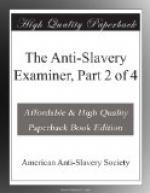The other cause of short crops has been the diminished amount of time for labor. One fourth of the time now belongs to the laborers, and they often prefer to employ it in cultivating their provision grounds and carrying their produce to market. Thus the estate cultivation is necessarily impeded. This cause operates very extensively, particularly on two classes of estates: those which lie convenient to market places, where the apprentices have strong inducements to cultivate their grounds, and those (more numerous still) which have harsh overseers, to whom the apprentices are averse to hire their time—in which cases they will choose to work for neighboring planters, who are better men. We should not omit to add here, that owing to a singular fact, the falling off of the crops appears greater than it really has been. We learned from the most credible sources that the size of the hogsheads had been considerably enlarged since abolition. Formerly they contained, on an average, eighteen hundred weight, now they vary from a ton to twenty-two hundred! As the crops are estimated by the number of hogsheads, this will make a material difference. There were two reasons for enlarging in the hogsheads,—one was, to lessen the amount of certain port charges in exportation, which were made by the hogshead; the other, and perhaps the principal, was to create some foundation in appearance for the complaint that the crops had failed because of abolition.
While we feel fully warranted in stating these as the chief causes of the diminished crops, we are at the same time disposed to admit that the apprenticeship is in itself exceedingly ill calculated either to encourage or to compel industry. We must confess that we have no special zeal to vindicate this system from its full share of blame; but we are rather inclined to award to it every jot and tittle of the dishonored instrumentality which it has had in working mischief to the colony. However, in all candor, we must say, that we can scarcely check the risings of exultation when we perceive that this party-fangled measure—this offspring of old Slavery in her dying throes, which was expressly designed as a compensation to the proprietor, HAS ACTUALLY DIMINISHED HIS ANNUAL RETURNS BY ONE THIRD! So may it ever be with legislation which is based on iniquity and robbery!
But the subject which excites the deepest interest in Jamaica is the probable consequences of entire emancipation in 1840. The most common opinion among the prognosticators of evil is, that the emancipated negroes will abandon the cultivation of all the staple products, retire to the woods, and live in a state of semi-barbarism; and as a consequence, the splendid sugar and coffee estates must be “thrown up,” and the beautiful and fertile island of Jamaica become a waste howling wilderness.




